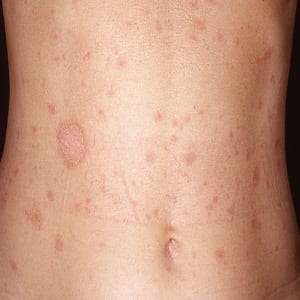
Jack is a 22-year-old who presents with a mildly itchy rash on the trunk and back. He first noticed a single red patch about two weeks ago.
He tried some topical over-the-counter corticosteroid cream, which helped with the itch, but the rash has progressed markedly in the past couple of days.
He is otherwise well, with no recent infective illness, no history of note and no regular medications.
He had a negative STI screen prior to commencing his current monogamous heterosexual relationship.
He has not changed any skincare or wash products recently.
The findings of note on examination are the oval and annular scaly erythematous papules and patches.
What is the diagnosis?
Correct!
Pityriasis rosea is typified by the appearance of a large herald patch on the chest, abdomen, or back, followed within days to weeks by a more disseminated rash characterised by smaller scaly erythematous ovoid lesions.
This usually develops in a descending fashion and predominantly involves the trunk, with potentially a few patches on the neck, arms and upper thighs.
A Christmas tree pattern is often observed, particularly on the back, as the oval lesions tend to align to the lines of skin cleavage (Langer lines), which are oriented obliquely on the back. Another suggestive feature is the presence of a collarette of scale at the peripheral edge of lesions.
The cause of pityriasis rosea is unclear. Cases have been reported in association with viral infections (particularly herpesvirus 6 and 7 but also influenza A and COVID-19), drug triggers (including ACEIs, NSAIDs and a number of antipsychotics) and post-vaccination.
Up to 70% of patients will have a mild viral prodrome prior to the rash emerging, but itch is usually the only symptom associated with the rash itself, which may also be asymptomatic.
The condition is most commonly seen in teenagers and young adults, with a very slight preponderance to affect women more than men.
The diagnosis is typically clinical, with biopsy or assessment of scale scrapings for fungal hyphae of benefit if the diagnosis is in doubt.
The papulosquamous eruption of secondary syphilis can closely mimic pityriasis rosea, but typically lacks the herald patch, and presents characteristically with a red-brown macular rash involving the palms and soles.
Guttate psoriasis frequently follows recent streptococcal tonsillitis, lacks a herald patch, and features coarser scale than that seen with pityriasis rosea.
The hypopigmented or hyperpigmented macules seen with pityriasis versicolor are usually located on the neck and trunk, with minimal erythema and fine scale, without a collarette appearance.
Pityriasis rosea typically resolves within 6-8 weeks without treatment. Skin discolouration may persist for months, particularly for those with darker skin tones.
Management includes topical steroids and/or oral antihistamines for itch if needed. For severe cases, oral acyclovir and phototherapy may be considered.
